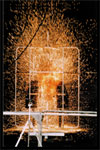
Unfortunately, electrical flashover or arc flash is one of the most deadly and least understood hazards of electricity and is prevalent in most industries.
Each year around 1,000 electrical accidents at work are reported and as many as 251 people die from their injuries. It is widely recognised the higher the voltage of an electrical power system, the greater the risk for people working on or near energised conductors and equipment. However, arc flash can actually be worse and more common at lower voltages and can cause devastating, severe burn injury and even death.
What is an electric arc flash?
An arc flash is usually caused by inadvertent contact between an energised conductor such as a bus bar or wire with another conductor or an earthed surface. When this occurs, the resulting short circuit current will melt the conductors, ionise the air and create a conducting plasma fireball with temperatures in the core of the arc that can reach upwards of 20,000 degrees centigrade. Severe injury and even death can not only occur to persons working on the electrical equipment but also to people located nearby.
Arc flash injury can include external burns to the skin, internal burns from inhaling hot gasses and vaporised metal, hearing damage, eye damage such as blindness from the ultraviolet light of the flash as well as many other devastating injuries. Depending on the severity of the arc flash, an explosive force known as an arc blast may also occur which can result in pressures of over 100 kiloPascal (kPa), launching debris as shrapnel at speeds up to 300 metres per second (m/s).
Survivors of such injuries may require extensive treatment and rehabilitation and the cost of these injuries can be extreme, physically, emotionally and financially. Whilst legislation requires businesses to perform risk assessments for all work activities, electric arc risk is often overlooked because most people are unsure how to assess and manage this hazard effectively.
How to manage the hazard
The arc flash hazard needs to be determined by risk assessment out of which, the decision to work live or dead and the required precautions will be derived. But the risk assessment should provide more information than this and it is advisable to adopt the step by step approach of Predict, Prevent, Protect and Publish that is recommended in the DuPont™ Arc-Guide:
Predict - the severity of the thermal effect of an arc flash by the amount of “incident energy” that a victim, standing at a given distance away from the arc, could receive.
Prevent - design out, eliminate or remove the hazard at its source.
Protect - where the risk cannot be controlled by prevention or where there is a residual risk of injury then it may be necessary to consider personal protective equipment (PPE) to prevent injury to the worker.
Publish - communicate and document results of site arc flash to those who are at risk.
In Summary
The DuPont™ Arc-Guide has been developed in conjunction with independent experts, to help companies better assess the arc flash hazards (with the use of simple calculators) and provide them with the knowledge on how to both reduce the severity and consequences of an arc flash.





